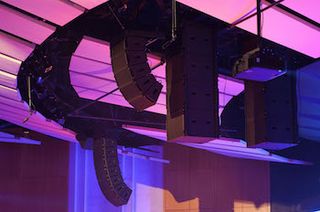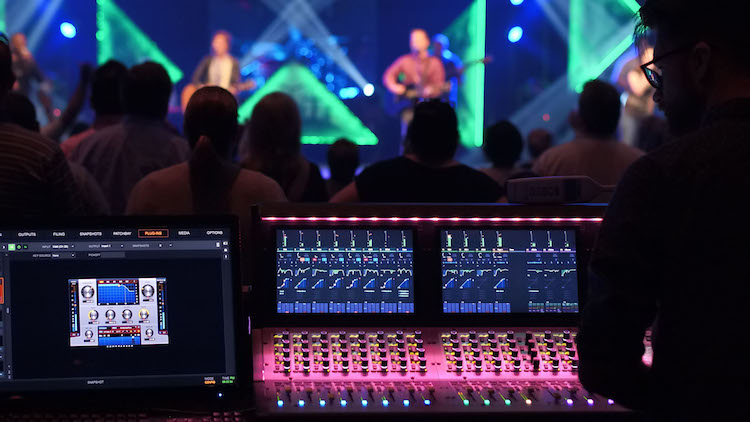
Dante-enabled mixing consoles were added to the front of house and monitor mixing positions, as well as the control room. When Josh Cash was hired to be the new tech director at The Met Church in Houston, TX, he made upgrading the venue’s outdated speaker system his top priority. While the church’s services had evolved with the times to incorporate a full praise band with electric instruments and a broadcast-caliber approach to video production, its audio was a different story. Prior to Cash’s hiring, The Met Church’s Jones Road campus had not undergone a major sound system overhaul since a building expansion in 1997. Atlanta, GA-based Scott Clark, a design engineer from integration firm Diversified Engineering Sciences, worked with Bose Professional on a solution to The Met’s challenges.
The Met Church’s Jones Road campus sanctuary is typical as far as medium-large worship spaces go. The room seats about 2,000, and its most challenging features from an acoustic standpoint are the height and width of the seating area. “The worship center is the standard Baptist church: a fan-shaped room with raked pews that go up side loges all the way to the balcony,” Clark said. “The stage is more contemporary, but the seating is more traditional. It’s a fairly tall seating shape with a reasonably short back wall—from the edge of the stage to the back wall is about 120 feet. Like most churches, you’re not really doing an extremely long throw; you’re doing what I would call a medium throw. But, you are doing a lot of vertical coverage, and that can present issues in terms of design. One of the reasons for choosing Bose was that, with the products that are available today, it’s really nice and easy to design an array system that has a lot of vertical coverage, with fewer boxes, that doesn’t have any high-frequency gaps.”
For his part, Cash knew exactly what he wanted from the new system. “I wanted it to sound the same everywhere,” he said. “And I wanted stereo for music. But I also didn’t want people to get drawn to the sides when somebody’s teaching, which is half of our service, and I think the most important part. So, I wanted center localization, as well.”
The Met Church system includes a total of 21 ShowMatch modules, eight ShowMatch SMS118 subwoofers, two Bose Panaray LT 9702 WR loudspeakers as side-fills, and four RoomMatch Utility RMU208 modules. Each of the two main arrays (arranged in left/right configuration and flown above the stage) consists of five Bose ShowMatch SM5s, one SM10, and two SM20s (equipped with SM20WG12 waveguides). The center array, installed to satisfy Cash’s design criteria for center localization, consists of one SM5, two SM10s, and two SM20s (equipped with SM20WG12 waveguides).

A smaller center localization array is flown in between the main left/right arrays. “The Panarays are located just to the outside of the left and right main arrays,” Clark said. “They are used as side-fill speakers for a very narrow slice of the front corner of the space that is not being covered in the high frequencies by the left and right arrays. So, we rotated these speakers to be 90 degrees in the vertical and 70 degrees in the horizontal, and they’re filling in just the front corners of the space.”
Clark utilized two subwoofer arrays, flown one behind the other. Each array consists of four SMS118 subwoofers. “Both of those arrays are behind the center localization array, and they’re spaced apart 68 inches face to face,” he said. “That provides a nice cardioid pattern to minimize energy behind the speakers going up into [the space] behind the stage wall and into the ceiling.”
A total of 12 Bose PowerMatch PM8500Ns powers the speakers. “The 8500Ns are eight-channel amps that you can bridge and also group into four channels per output,” Clark said. “The subwoofers require four channels each, so one amplifier can handle two subwoofers each. With ShowMatch, the low frequency needs two channels bridged, and the high frequency needs one channel. And we supplied power to each box individually, so there are no boxes that are paralleled with the line array speakers. The side fills are paralleled and the under-balcony fills are in pairs.” A Bose ControlSpace ESP-880 with a Dante expansion card is used for digital signal processing.










